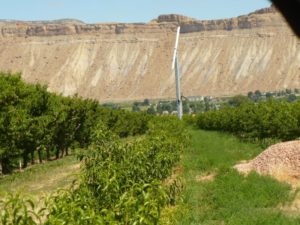
Last December, CWLT completed conservation work with Roblee and Clare Talbott of C & R Farms. This 22-acre, highly-productive peach and apricot orchard is the third conservation project for the family, who have grown fruit on East Orchard Mesa since 1979.
Projects like this are possible in Colorado in part because we have access to several sources of funding to purchase conservation easements on valuable acreage. Financial assistance through Great Outdoors Colorado (GOCO), the USDA Natural Resources Conservation Service (NRCS) Farm Bill program, and our Community Separator Program partners (the City of Fruita and Town of Palisade), supports such conservation efforts. Dedicated farm families, like Roblee and Clare, were able to use funding to reinvest and expand their operation to include their son and daughter, who want to remain active participants in the family farm.
A recent Colorado State University (CSU) study surveyed and modelled the economic impact of such federal payments to estimate how they were being used by recipients. In Colorado, nearly $80 million in conservation easement payments generated more than $174 million in economic activity between 2009 and 2017. Further, 32.7% of recipients changed their agricultural practices in some way, including: irrigation system improvements (27.9%), increases in acreage (14%), and changes to crop mix and rotation (2.3%). In all, it was estimated that land trusts leveraged federal funds to receive additional local, state, or private dollars at a rate of 2 to 1.
CSU’s economic impact analysis helps bolster confidence that conservation easement payments are an asset to rural communities in Colorado. Land trusts play a vital role in assuring that these funds are well leveraged. Click here to read the entire study.
Share
SEP
2018

